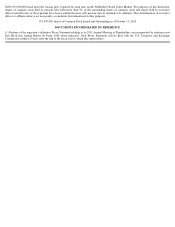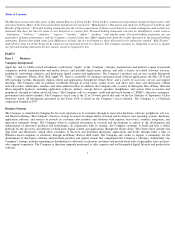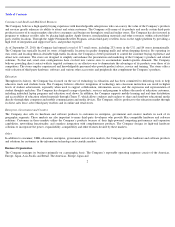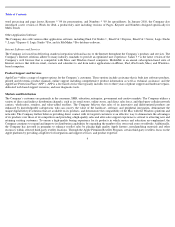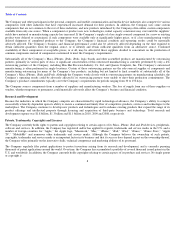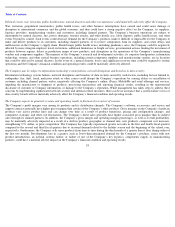Apple 2010 Annual Report Download - page 12
Download and view the complete annual report
Please find page 12 of the 2010 Apple annual report below. You can navigate through the pages in the report by either clicking on the pages listed below, or by using the keyword search tool below to find specific information within the annual report.
Table of Contents
solely responsible for protecting the Company’
s products. The Company believes the duration of the applicable patents it has been granted is
adequate relative to the expected lives of its products. Due to the fast pace of innovation and product development, the Company’
s products are
often obsolete before the patents related to them expire, and sometimes are obsolete before the patents related to them are even granted.
Many of the Company’
s products are designed to include intellectual property obtained from third parties. While it may be necessary in the
future to seek or renew licenses relating to various aspects of its products and business methods, the Company believes, based upon past
experience and industry practice, such licenses generally could be obtained on commercially reasonable terms; however, there is no guarantee
such licenses could be obtained at all. Because of technological changes in the industries in which the Company competes, current extensive
patent coverage, and the rapid rate of issuance of new patents, it is possible certain components of the Company’
s products and business
methods may unknowingly infringe existing patents or intellectual property rights of others. From time to time, the Company has been notified
that it may be infringing certain patents or other intellectual property rights of third parties.
Foreign and Domestic Operations and Geographic Data
The U.S. represents the Company’s largest geographic marketplace. Approximately 44% of the Company’
s net sales in 2010 came from sales to
customers inside the U.S. Final assembly of the Company’s products is currently performed in the Company’
s manufacturing facility in Ireland,
and by external vendors in California, Texas, the People’s Republic of China (“China”),
the Czech Republic and the Republic of Korea
(“Korea”). Currently, the supply and manufacture of many critical components is performed by sole-sourced third-
party vendors in the U.S.,
China, Germany, Ireland, Israel, Japan, Korea, Malaysia, the Netherlands, the Philippines, Taiwan, Thailand and Singapore. Sole-sourced third-
party vendors in China perform final assembly of substantially all of the Company’
s Macs, iPhones, iPads and iPods. Margins on sales of the
Company’
s products in foreign countries, and on sales of products that include components obtained from foreign suppliers, can be adversely
affected by foreign currency exchange rate fluctuations and by international trade regulations, including tariffs and antidumping penalties.
Information regarding financial data by geographic segment is set forth in Part II, Item 7 and Item 8 of this Form 10-
K and in Notes to
Consolidated Financial Statements at Note 9, “Segment Information and Geographic Data.”
Seasonal Business
The Company has historically experienced increased net sales in its first and fourth fiscal quarters compared to other quarters in its fiscal year
due to seasonal demand of consumer markets related to the holiday season and the beginning of the school year; however, this pattern has been
less pronounced following the introductions of iPhone and iPad. This historical pattern should not be considered a reliable indicator of the
Company’s future net sales or financial performance.
Warranty
The Company offers a basic limited parts and labor warranty on most of its hardware products, including Macs, iPhones, iPads and iPods. The
basic warranty period is typically one year from the date of purchase by the original end-user. The Company also offers a 90-
day basic warranty
for its service parts used to repair the Company’
s hardware products. In addition, consumers may purchase the APP, which extends service
coverage on many of the Company’s hardware products in most of its major markets.
Backlog
In the Company’
s experience, the actual amount of product backlog at any particular time is not a meaningful indication of its future business
prospects. In particular, backlog often increases in anticipation of or immediately following new product introductions as dealers anticipate
shortages. Backlog is often reduced once dealers and customers believe they can obtain sufficient supply. Because of the foregoing, backlog
should not be considered a reliable indicator of the Company’s ability to achieve any particular level of revenue or financial performance.
9



